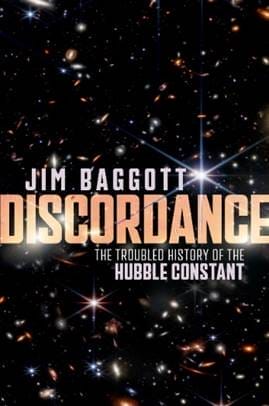
We look at this new and interesting book by Jim Baggott. See more about Discordance The Troubled History of the Hubble Constant here.
Discordance The Troubled History of the Hubble Constant, reviewed
We are living in interesting times for studies about our universe. It looks like it is still expanding, fair enough if the big bang did it’s thing, and exploded out from an incredibly small amount of space and matter. But, as the data increasingly suggests, the rate of the expansion is not only continuing, but also increasing the rate at which it does so. Baggott takes us on an interesting, well informed and clearly explained journey around the important developments and discoveries, especially over the last century or so.
At some points the maths and the physics naturally left us behind, but, overall this is an accessible and comprehensible book for the wider reader. Time and time again it seems like our best and deepest thinkers have to conceive theoretical ideas and then often wait decades, often beyond their own lifetimes, before humanity has built sufficient tools to then test them. Often then, such was the brilliance of Einstein and others, their concepts turned out to be right. The clear example of the concept of black holes, long, long before it was ever possible to definitively proof their existence. This has repeatedly been the process, which the Hubble Telescope, Cern and the Higgs boson, and now with the James Watt Telescope, have all helped us to then conclusively prove or disprove concepts. All of this of course a massive riposte to the recent insane cuts in scientific research, and evidence based concepts.
It is an exciting time new massive arrays coming online, and the far great capacity of JW and more to scan more of the sky, in higher resolution. Faster methodologies are also emerging to analyse what is being captured too. All of which means that new discoveries are being made near daily too. Baggot helps to communicate an interesting overview of these developments, and captures the enthusiasm that is out there in terms of sharing of ideas and robustly testing previously held ideas. Naturally dark matter and dark energy can still seem slightly questionable, as they are, by their nature, currently impossible, or at least extremely difficult to measure, observe or capture. At the same time, something has to be there to account for the fact that we can see, and measure so little of what must be around us. It does show we still have a long way to go in terms of understanding how the universe works and what is happening around us. Books like this help to communicate why this is important, interesting and well worth studying and investment. Check it out.
More about the book Discordance
The troubled history of the Hubble constant: a story littered with crises of confidence, astonishing discoveries, and extraordinary personalities, which still continues today.
From the award-winning science-writer and author of Quantum Drama.
In 1927 Georges Lemaître argued that our universe is expanding, a conclusion rendered more startling by the astronomical data that backed it up, presented two years later by Edwin Hubble. The speed of this expansion is governed by Hubble’s constant, and Discordance tells its troubled history.
This unpredictable and fascinating story begins with the first tentative steps to measure the distances to nearby stars and galaxies. It traces the extraordinary interplay between cosmological theory and astronomical observation which has given us the standard Big Bang theory.
It was not all plain sailing, and the narrative takes us through the discovery of dark matter, the Hubble Wars of the 1970s, the invention of cosmic inflation, and other crucial scientific moments. Further satellite missions were expected to add to the clarity of our measurements. But from about 2009 onward, the results began to diverge and complicate our understanding of this expansion. This is the Hubble tension and perhaps even a crisis.
This is science perched right at the frontier. Our scientific answers can sometimes be of only fleeting interest, for it is often the questions that fascinate. As Discordance shows, in the troubled history of the Hubble constant and the sometimes uneasy relationship between cosmological theory and observation, we have never been short of fascinating questions.
Jim Baggott is an award-winning science writer. Trained as a scientist in the Universities of Oxford and Stanford, and a former lecturer at the University of Reading, he has written popular books on science, philosophy, and history. His books include Higgs (2012), Mass (2017), for which he won the 2020 Premio Cosmos prize, Quantum Reality (2020), Quantum Space (2018), and, with the late John L. Heilbron, Quantum Drama (2024). His books have been translated into a dozen different languages, and he has won awards both for his scientific research and his science writing.
See more reviews here.














